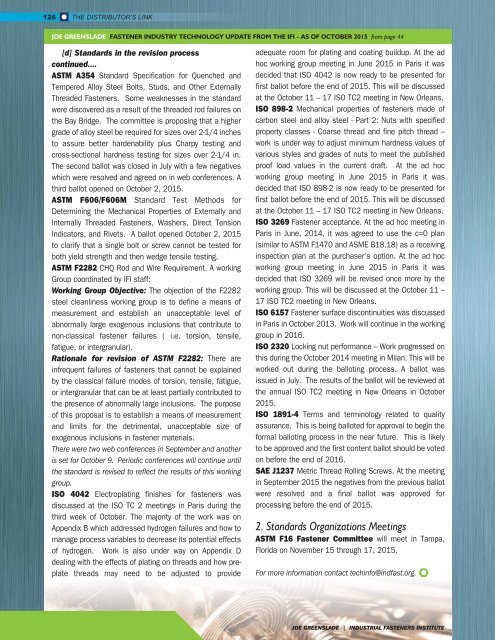WINTER 2016
Distributor's Link Magazine Winter Issue 2016 / Vol 39 No1
Distributor's Link Magazine Winter Issue 2016 / Vol 39 No1
You also want an ePaper? Increase the reach of your titles
YUMPU automatically turns print PDFs into web optimized ePapers that Google loves.
126 THE DISTRIBUTOR’S LINK<br />
JOE GREENSLADE FASTENER INDUSTRY TECHNOLOGY UPDATE FROM THE IFI - AS OF OCTOBER 2015 from page 44<br />
[d] Standards in the revision process<br />
continued....<br />
ASTM A354 Standard Specification for Quenched and<br />
Tempered Alloy Steel Bolts, Studs, and Other Externally<br />
Threaded Fasteners. Some weaknesses in the standard<br />
were discovered as a result of the threaded rod failures on<br />
the Bay Bridge. The committee is proposing that a higher<br />
grade of alloy steel be required for sizes over 2-1/4 inches<br />
to assure better hardenability plus Charpy testing and<br />
cross-sectional hardness testing for sizes over 2-1/4 in.<br />
The second ballot was closed in July with a few negatives<br />
which were resolved and agreed on in web conferences. A<br />
third ballot opened on October 2, 2015.<br />
ASTM F606/F606M Standard Test Methods for<br />
Determining the Mechanical Properties of Externally and<br />
Internally Threaded Fasteners, Washers, Direct Tension<br />
Indicators, and Rivets. A ballot opened October 2, 2015<br />
to clarify that a single bolt or screw cannot be tested for<br />
both yield strength and then wedge tensile testing.<br />
ASTM F2282 CHQ Rod and Wire Requirement. A working<br />
Group coordinated by IFI staff:<br />
Working Group Objective: The objection of the F2282<br />
steel cleanliness working group is to define a means of<br />
measurement and establish an unacceptable level of<br />
abnormally large exogenous inclusions that contribute to<br />
non-classical fastener failures ( i.e. torsion, tensile,<br />
fatigue, or intergranular).<br />
Rationale for revision of ASTM F2282: There are<br />
infrequent failures of fasteners that cannot be explained<br />
by the classical failure modes of torsion, tensile, fatigue,<br />
or intergranular that can be at least partially contributed to<br />
the presence of abnormally large inclusions. The purpose<br />
of this proposal is to establish a means of measurement<br />
and limits for the detrimental, unacceptable size of<br />
exogenous inclusions in fastener materials.<br />
There were two web conferences in September and another<br />
is set for October 9. Periodic conferences will continue until<br />
the standard is revised to reflect the results of this working<br />
group.<br />
ISO 4042 Electroplating finishes for fasteners was<br />
discussed at the ISO TC 2 meetings in Paris during the<br />
third week of October. The majority of the work was on<br />
Appendix B which addressed hydrogen failures and how to<br />
manage process variables to decrease its potential effects<br />
of hydrogen. Work is also under way on Appendix D<br />
dealing with the effects of plating on threads and how preplate<br />
threads may need to be adjusted to provide<br />
adequate room for plating and coating buildup. At the ad<br />
hoc working group meeting in June 2015 in Paris it was<br />
decided that ISO 4042 is now ready to be presented for<br />
first ballot before the end of 2015. This will be discussed<br />
at the October 11 – 17 ISO TC2 meeting in New Orleans.<br />
ISO 898-2 Mechanical properties of fasteners made of<br />
carbon steel and alloy steel - Part 2: Nuts with specified<br />
property classes - Coarse thread and fine pitch thread –<br />
work is under way to adjust minimum hardness values of<br />
various styles and grades of nuts to meet the published<br />
proof load values in the current draft. At the ad hoc<br />
working group meeting in June 2015 in Paris it was<br />
decided that ISO 898-2 is now ready to be presented for<br />
first ballot before the end of 2015. This will be discussed<br />
at the October 11 – 17 ISO TC2 meeting in New Orleans.<br />
ISO 3269 Fastener acceptance. At the ad hoc meeting in<br />
Paris in June, 2014, it was agreed to use the c=0 plan<br />
(similar to ASTM F1470 and ASME B18.18) as a receiving<br />
inspection plan at the purchaser’s option. At the ad hoc<br />
working group meeting in June 2015 in Paris it was<br />
decided that ISO 3269 will be revised once more by the<br />
working group. This will be discussed at the October 11 –<br />
17 ISO TC2 meeting in New Orleans.<br />
ISO 6157 Fastener surface discontinuities was discussed<br />
in Paris in October 2013. Work will continue in the working<br />
group in <strong>2016</strong>.<br />
ISO 2320 Locking nut performance – Work progressed on<br />
this during the October 2014 meeting in Milan. This will be<br />
worked out during the balloting process. A ballot was<br />
issued in July. The results of the ballot will be reviewed at<br />
the annual ISO TC2 meeting in New Orleans in October<br />
2015.<br />
ISO 1891-4 Terms and terminology related to quality<br />
assurance. This is being balloted for approval to begin the<br />
formal balloting process in the near future. This is likely<br />
to be approved and the first content ballot should be voted<br />
on before the end of <strong>2016</strong>.<br />
SAE J1237 Metric Thread Rolling Screws. At the meeting<br />
in September 2015 the negatives from the previous ballot<br />
were resolved and a final ballot was approved for<br />
processing before the end of 2015.<br />
2. Standards Organizations Meetings<br />
ASTM F16 Fastener Committee will meet in Tampa,<br />
Florida on November 15 through 17, 2015.<br />
For more information contact techinfo@indfast.org.<br />
JOE GREENSLADE | INDUSTRIAL FASTENERS INSTITUTE

















